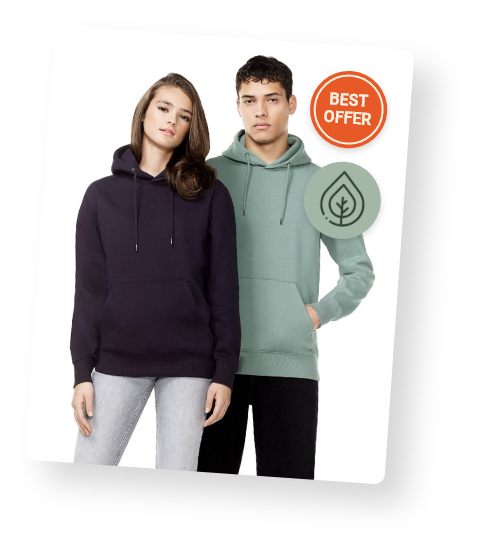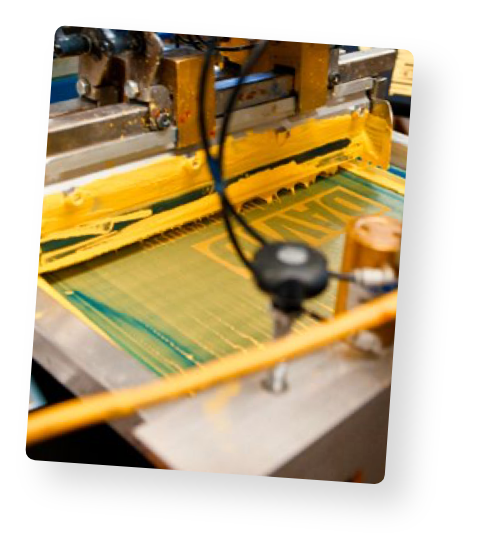T-Shirts in all shapes and colors

The classic of all – T-shirts are now available in all possible variants: unisex, women’s, V-neck, sleeveless, long-sleeved, oversize, slim fit and many more. Below you will find our bestsellers. If you cannot find what you are looking for or have questions about the implementation of the desired branding, simply contact us and let us advise you.
Our Product Range
More selection of t-shirts are available in our shop.
We would be happy to make you an individual offer for the refinement of T-shirts, be it with print, embroidery or plot. Use our request form or simply send us an email to info@cotton.de with your requirements.
The development of the T-shirt
The t-shirt gets its name from its characteristic T-shape, which the outstretched sleeves form with the body.
Originally, t-shirts were worn as underwear. They became popular after the Second World War, above all thanks to the film stars Marlon Brando and James Dean. The T-shirts started their triumphal procession together with the possibility of printing them and thus expressing messages and preferences.
T-shirt quality and materials
The best way to decide if a t-shirt fits your needs is to order a sample from us. Depending on the quality, this costs around €2 to €5 per T-shirt. But then the t-shirt is yours, you see the fit, size, cut and color, you can wear it, wash it and test it extensively in everyday life.
The heaviness of the fabric, given in grams per square meter or g/m² for short, is often equated with better quality. However, this is only partially true, the higher the weight, the thicker the fabric. Most T-shirts are between 150g/m² and 190g/m². A key factor in the quality of the entire product is the quality and processing of the cotton.
There are more and more manufacturers who offer very light (from 80 – 140 g/qm) but high quality T-shirts.
Materials: Most t-shirts are made from 100% cotton. Cotton fabrics are considered very skin-friendly, have a low allergy potential, do not scratch and are absorbent. However, once they get wet, they dry very slowly.
Other common material compositions for T-shirts are 100% polyester (especially in the sports sector because of the quick drying and for sublimation prints), cotton-polyester blends, bamboo viscose, triblend (mixture of the three fibers cotton, polyester and viscose), Tencel, hemp.
T-shirt cuts, sizes, labels
Of the cuts, the classic unisex shirt (short-sleeved crew-neck shirt that is not tailored to fit the body) is still the most common.
Here is a list of different T-shirt types without claiming to be complete:
- Ringer shirt (sleeves and collar cuffs have a contrasting color to the rest of the shirt)
- Body fit or slim fit cuts (body-hugging or tight-fitting)
- V-neck (shirt with V-neck)
- Scoop Neck (with deep round neckline)
- Long sleeve shirt
- Layered T-Shirt (a long-sleeved shirt with a contrast-colored neckline and contrast-colored attached short sleeves)
- Sleeveless shirts also called muscle, armpit or athletic shirts
- Henley Shirt (with button placket)
- Vintage shirts (prewashed, faded look)
- different women’s models see extra chapter
Most T-shirts these days are circular knit, i.e. without side seams (so-called tubular fabric).
For T-shirts, the clothing size is usually given in American sizes (XS = extra small, S = small, M = medium, L = large, XL = extra large, can be extended downwards and upwards with additional Xs, e.g. XXS or XXL). Since these sizes are not standardized, they can vary from manufacturer to manufacturer or within a manufacturer’s product range (so the size of a women’s shirt in M usually differs from a men’s or unisex shirt from the same manufacturer). To be on the safe side, we recommend trying it on beforehand.
For children’s sizes, some manufacturers use the height in cm as the size specification, so the size should be 152 for children who are up to 152cm tall, others use the age, e.g. size 12/14 recommended for 12-14 year olds, others also use the designation S, M, L, XL, whereby e.g. Hanes size M should correspond to height 133 – 140.
The Textile Labeling Act stipulates that every textile must have a detailed composition of raw materials. This information is usually attached to a label on the neck together with the care label, size information and manufacturer’s logo. Some manufacturers such as Continental Clothing and Stanley and Stella only put a small size label on the neck and provide information about the product name, composition of raw materials and care treatment on an extra label in the inner seam and thus do without a conspicuous branding with their own company label. Others use printed labels (Hanes Tagless) or Tear Away Labels (here you can easily tear out the manufacturer’s logo).


